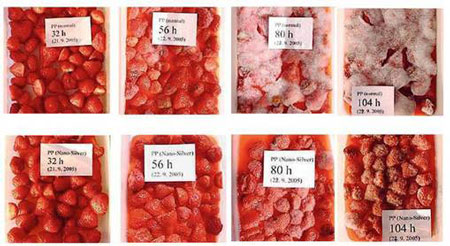| Posted: February 16, 2009 |
Designer food or disaster - what nanotechnology might bring to the food sector |
|
(Nanowerk News) Food technology is regarded as one of the industry sectors where nanotechnology will play an important role in the future. It is commonly distinguished between two forms of nanofood applications: food additives (nano inside) and food packaging (nano outside). Nanoscale food additives may for example be used to influence product shelf life, texture, flavour, nutrient composition or even detect food pathogens and provide functions as food quality indicators. In the context of food packaging, nanotechnologies are mainly considered to be of use to increase product shelf life, indicate spoilt ingredients or generally increase product quality, e.g. by preventing gas flow across product packaging.
|
|
Promising applications combining nanotechnologies and food are also expected to result from new encapsulation technologies. Such nano encapsulation systems can be used to add additional nutrients without changing a product’s flavour or quality. This might enable producers to integrate nutrients which are not naturally occurring, or which could so far not be integrated due to reasons of chemistry. The advantages of such encapsulation systems also encompass extended shelf life, protection of the encapsulated ingredients from the surrounding media and undesired interaction during food processing, as well as delivery of certain contents to a specific target site within the body.
|
 |
| Strawberries in a conventional food container (upper row) and nano-silver container (lower row). (Test series and pictures: The Innovation Society Ltd.)
|
|
Although such opportunities appear to be very promising at a first glance, they may also bring new risks into play. E.g., it is not fully understood whether enhancing the bioavailability of certain nutrients or food additives might negatively affect human health (Emerging trends of nanoparticles application in food technology: Safety paradigms).
|
|
TA-Swiss, the Swiss centre for technology assessment, has recently analysed the situation concerning nanotechnologies and food in Switzerland (Studie "Nanotechnologie im Bereich der Lebensmittel"), considering in particular food additives that have been used in Switzerland for many years (e.g., carotenoids, micelles and silicon dioxide). Although, according to the TA-Swiss study, there are no indications at this time that nanoparticles are used in Switzerland which have been shown to be dangerous to human health, in most cases no specific tests have been conducted to clarify possible new risks depending on particle size. Similarly to any other industry sector, the current lack of methodologies and guidelines on how to assess potential risks emanating from certain substances at the nanoscale complicates risk assessment in the food sector.
|
|
The regulatory system for food additives in Switzerland sticks to the so-called “positive principle“. Food additives may only be used if they have been tested and appear on a positive list, identifiable by an E-number. In Switzerland, silicon dioxide (E 551), iron oxide (E172), titanium dioxide (E 171), silver (E 174), gold (E 175) and aluminium (E 173) are registered and on the positive list of food additives. These substances may be used in certain foods according to the standard of Good Production Practice.
|
|
Most food additives on the positive list, however, have only been used and tested in the macroscale form so far. Since particle size is not a relevant criterion to distinguish substances in safety tests (yet), the nanoscale form of these substances is implicitly admitted too. This problem also exists concerning e.g. chemicals legislation or information disclosure obligations through material safety data sheets.
|
|
An emerging trend in food packaging makes use of silver’s antibacterial properties by implementing silver nanoparticles into food containers. The potential effect on food shelf life is illustrated in figure 1. Using fresh strawberries, our test series clearly demonstrated that the silver-coated food container reduced mould growth. Critics, however, argue that it is not yet clearly understood whether and how nanoparticles might pass out of the packaging into the food, and what effects they might exhibit once they have been ingested.
|
|
Even if such nanosilver applications might not be available at this time in Switzerland’s stores, with the possibility to globally order goods over the internet, products with less stringent or different safety standards are readily available to consumers. Particularly in the food sector, it will be of utmost importance to deal with the mentioned safety issues in an early phase in order to avoid harsh consumer (over)reactions.
|

